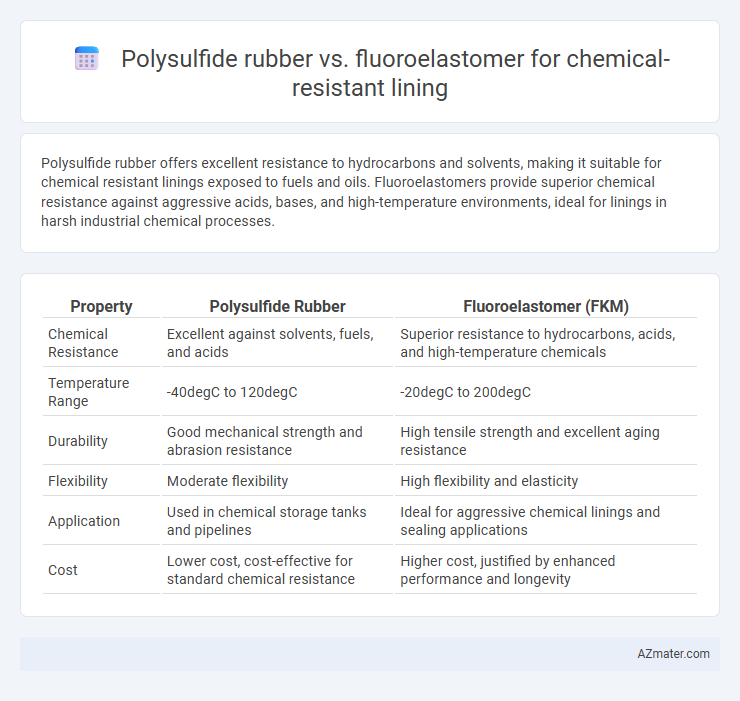Polysulfide rubber offers excellent resistance to hydrocarbons and solvents, making it suitable for chemical resistant linings exposed to fuels and oils. Fluoroelastomers provide superior chemical resistance against aggressive acids, bases, and high-temperature environments, ideal for linings in harsh industrial chemical processes.
Table of Comparison
| Property | Polysulfide Rubber | Fluoroelastomer (FKM) |
|---|---|---|
| Chemical Resistance | Excellent against solvents, fuels, and acids | Superior resistance to hydrocarbons, acids, and high-temperature chemicals |
| Temperature Range | -40degC to 120degC | -20degC to 200degC |
| Durability | Good mechanical strength and abrasion resistance | High tensile strength and excellent aging resistance |
| Flexibility | Moderate flexibility | High flexibility and elasticity |
| Application | Used in chemical storage tanks and pipelines | Ideal for aggressive chemical linings and sealing applications |
| Cost | Lower cost, cost-effective for standard chemical resistance | Higher cost, justified by enhanced performance and longevity |
Introduction to Chemical Resistant Linings
Chemical resistant linings protect surfaces from aggressive chemicals, enhancing durability and safety in industrial applications. Polysulfide rubber offers excellent resistance to oils, solvents, and some acids, making it suitable for moderate chemical exposure. Fluoroelastomers provide superior chemical resistance against a broader range of aggressive substances, including acids, bases, and solvents, ideal for high-performance, demanding environments.
What is Polysulfide Rubber?
Polysulfide rubber is a synthetic elastomer known for its excellent chemical resistance, particularly against solvents, acids, and fuels, making it ideal for chemical-resistant linings. Its sulfur-sulfur bonds create a flexible, durable material that resists permeation and degradation in harsh chemical environments. Compared to fluoroelastomers, polysulfide rubber offers superior resistance to swelling and good mechanical properties, though fluoroelastomers excel in extreme temperature and oxidative stability.
What is Fluoroelastomer (FKM)?
Fluoroelastomer (FKM) is a highly durable synthetic rubber known for its exceptional chemical resistance, particularly against hydrocarbons, oils, and acids, making it ideal for chemical resistant linings in aggressive environments. Compared to polysulfide rubber, FKM offers superior temperature resistance, typically up to 200-250degC, and enhanced stability in harsh chemical exposures. Its unique fluorine content provides excellent resistance to fuels, solvents, and oxidative degradation, positioning it as a premium choice for high-performance sealing and lining applications.
Key Chemical Resistance Properties Compared
Polysulfide rubber exhibits excellent resistance to water, aliphatic hydrocarbons, and certain acids but struggles against aromatic hydrocarbons and strong oxidizers. Fluoroelastomers show superior chemical resistance across a broader spectrum, including resistance to hydrocarbons, synthetic lubricants, fuels, and concentrated acids and bases. Their enhanced resistance to solvents and high-temperature stability makes fluoroelastomers ideal for demanding chemical lining applications.
Temperature Resistance: Polysulfide vs Fluoroelastomer
Polysulfide rubber offers moderate temperature resistance, typically withstanding continuous exposure up to 150degC, making it suitable for many chemical-resistant lining applications under moderate thermal conditions. Fluoroelastomers provide superior temperature resistance, maintaining chemical integrity and elasticity at temperatures up to 200degC or higher, ideal for harsh environments requiring prolonged exposure to heat. The enhanced thermal stability of fluoroelastomers makes them preferable for high-temperature chemical resistance compared to polysulfide rubber linings.
Mechanical Performance and Durability
Polysulfide rubber demonstrates excellent mechanical flexibility and tensile strength, making it highly effective in absorbing impact and accommodating substrate movement in chemical resistant lining applications. Fluoroelastomers provide superior chemical resistance and thermal stability, maintaining structural integrity under aggressive chemical exposure and high-temperature conditions. The durability of polysulfide rubber excels in moderate environments, while fluoroelastomers outperform in long-term exposure to harsh chemicals and extreme temperatures, ensuring prolonged service life in demanding industrial settings.
Application Suitability in Various Industries
Polysulfide rubber offers excellent resistance to fuels, oils, and solvents, making it ideal for sealing and lining applications in the automotive and aerospace industries where hydrocarbon exposure is prevalent. Fluoroelastomers provide superior chemical resistance to aggressive acids, lubricants, and solvents, making them the preferred choice in chemical processing, pharmaceutical, and oil and gas industries for high-performance sealing and lining. The selection between polysulfide rubber and fluoroelastomer depends on the specific chemical environment, temperature range, and mechanical stress requirements of each industry.
Cost and Economic Considerations
Polysulfide rubber offers a more cost-effective solution for chemical resistant lining compared to fluoroelastomers, making it suitable for budget-conscious industrial applications. While fluoroelastomers provide superior chemical resistance and durability in aggressive environments, their higher initial cost impacts overall project economics. Evaluating the trade-off between upfront material expense and long-term maintenance costs is essential for optimizing lining performance within specific industrial budgets.
Installation and Maintenance Requirements
Polysulfide rubber offers straightforward installation with its flexible curing process and ease of application in seamless linings, making it ideal for moderate chemical exposure environments. Fluoroelastomers require precise installation conditions, including controlled temperature and curing times, to achieve optimal chemical resistance and prevent defects. Maintenance of polysulfide linings involves periodic inspection for swelling or cracking, while fluoroelastomer linings demand less frequent maintenance due to superior chemical stability and abrasion resistance.
Choosing the Right Material: Polysulfide Rubber or Fluoroelastomer?
Polysulfide rubber offers excellent resistance to water, acids, and bases, making it ideal for chemical resistant linings exposed to moderate chemical environments and flexibility demands. Fluoroelastomer excels in high-temperature resistance and aggressive chemical exposure, including fuels, oils, and solvents, providing superior durability and longevity for harsh industrial applications. Selecting the right material depends on specific chemical exposure, temperature range, and mechanical stress, with polysulfide favored for cost-effective sealants and fluoroelastomer preferred for demanding conditions requiring exceptional chemical and thermal resistance.

Infographic: Polysulfide rubber vs Fluoroelastomer for Chemical resistant lining
 azmater.com
azmater.com